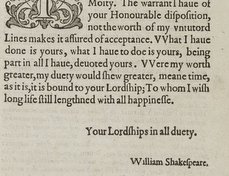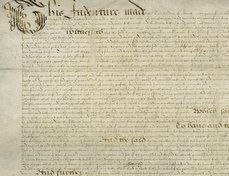Reproduced by permission of Shakespeare Birthplace Trust
Terms of use
The Shakespeare Birthplace Trust has graciously contributed images under a Creative Commons Attribution NonCommerical ShareAlike 4.0 International license. Visitors may download, link to and cite the images for personal research only. Any further use, including, but not limited to, unauthorized downloading or distribution of the images, commercial or third party use, is strictly prohibited. Visitors must contact the Shakespeare Birthplace Trust to request additional use, at: images.scla@shakespeare.org.uk
Document-specific information
Date: March 15, 1609
Repository: The Shakespeare Birthplace Trust, Stratford-upon-Avon, UK
Call number and opening: ER27/6
View online bibliographic record
Robert Bearman, "Shakespeare sues John Addenbrooke: the order to produce Addenbrooke at the next court sitting," Shakespeare Documented, https://doi.org/10.37078/522.
Shakespeare Birthplace Trust, ER27/6. See Shakespeare Documented, https://doi.org/10.37078/522.
On August 17, 1608, William Shakespeare (or his family or agents acting on his behalf) began an action in the Stratford court of record to recover a debt of £6 from John Addenbrooke. The case dragged on until at least June 7, 1609. The register recording the court’s proceedings during this period is lost but many cases which came before it generated a sequence of writs and other loose papers. Fortunately, seven such items survive for the case between Shakespeare and Addenbrooke, allowing us to track the progress of this particular claim in reasonable, though not complete, detail. These surviving documents are in Latin and all have small central holes or tears along one edge indicating they were once held together by a tie or pin to form a bundle. R.B. Wheler, probably broke up the bundle when he discovered the file in 1800, as two of the items, the order to produce Addenbrooke and writ to bring Addenbrooke’s surety, Thomas Hornby to court subsequently became part of his papers. The writs all bear the name “Greene” in the bottom right corner, indicating that they had been issued with the authority of Thomas Greene, the Corporation’s steward, who acted as the court’s legal officer.
Addenbrooke, described early in his career as a yeoman but later as a gentleman, was married at Tanworth-in-Arden in 1574 and was buried there on June 19, 1609 (perhaps the reason why the case seems to have petered out). His place of residence gave rise to another problem: as Stratford’s court of record had no jurisdiction outside the borough boundary, its officers were not able to carry out its instructions in cases where the defendant lived elsewhere. None of the papers explains how Addenbrooke contracted the substantial debt but they do provide evidence of Shakespeare’s local dealings with a man of some substance not obviously linked to a routine business transaction. Due to an outbreak of plague, the London theaters were closed from July 1608 to December 1609, leading to a reduction in Shakespeare’s income, and this may have been a factor in this attempt to recover an outstanding debt or loan.
On the same day as the verdict, March 15, 1609, another writ was issued to the sergeants-at-mace to arrest John Addenbrooke and to bring him to the next court to give satisfaction to William Shakespeare, shown here. Addenbrooke was now responsible not only for the debt of £6 (specified for the first time in the surviving documentation) but also for 24s. in expenses. These costs would have included those listed in the writ recording the court’s ruling, and others expenses incurred in the long drawn-out process. The sergeant’s response (by Francis Boyce) illustrates the limitations of the court’s jurisdiction for he reported that Addenbrooke “is not to be found within the liberty of the borough.” This did not mean that he had fled but simply that, residing in Tanworth, the court’s officers had no power to arrest or detain him.
Had the court register survived, it would have recorded any further proceedings, most importantly whether Shakespeare ever succeeded in recovering his money. Addenbrooke was buried at Tanworth twelve days after the final document, leaving no will.
[recto]
Stratford borough
The sergeants at mace there are instructed that they arrest John Addenbrooke and that they have his body in the presence of the bailiff of the said borough at the next court of record there held to give satisfaction to William Shakespeare gentleman in both a debt of six pounds which the said William recovered against him in the same court and of 24 shillings which were awarded to him for damages and the costs which he sustained by the occasion of the detention of the said debt; and to have this order then. Witness Francis Smith junior gentleman bailiff there, 15 March in the sixth year of the reign of King James.
[verso: endorsed]
The within-named John is not found within the liberty of the borough.
Francis Boyce serjeant
[recto]
Stratford
Burgus
Preceptum est Servientibus ad Clavam ibidem quod Capiant seu etc Iohannem Addenbrooke si etc et eum salvo etc ita quod habeant Corpus eius coram balliuo burgi
predicti ad proximam Curiam de Recordo ibidem tenendam ad satisfaciendum Willelmo Shackspeare generoso tam de sex libris debiti quas predictus Willelmus in eadem Curia
versus eum recuperavit quam de viginti et quatuor solidis qui ei adiudicati fuerunt pro dampnis et custagiis suis quos sustinuit occacione
etencionis debiti predicti Et habeant ibi tunc hoc preceptum Teste ffrancisco Smyth Iuniore generoso ballivo ibidem xvo die Marcii Annis regni domini nostri
Iacobi Dei gracia Regis Anglie ffrancie et Hibernie sexto et Scotie xlijo
Greene
[verso: endorsed]
Infranominatus
Iohannes non est
inventus infra
libertatem huius
burgi
ffranciscus Boyce
serviens
Written by Robert Bearman
Last updated May 19, 2020



![BRU15/5/139 [2], thumbnail detail](https://shakespearedocumented.folger.edu/sites/default/files/styles/document_thumbnail/public/document-thumbnails/SBT_BRU15_5_139_order_Addenbrooke_Shakespeare_1608_002_thumbnail%20detail.jpg?itok=c7UVjF0y)













